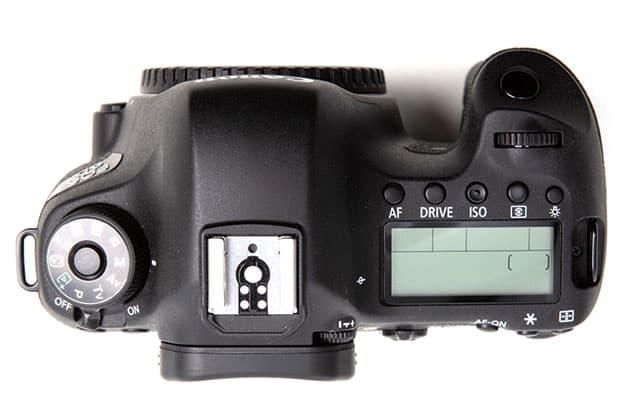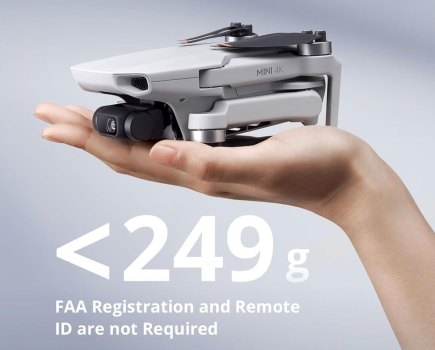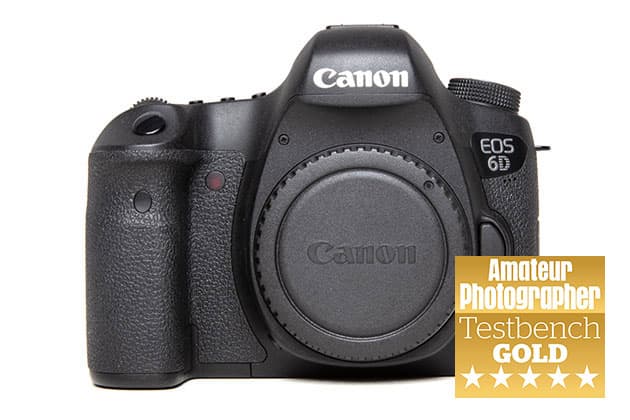
The EOS 6D’s body is weather-sealed to prevent dust and moisture from damaging the internals
The EOS 6D will be remembered as Canon’s first ‘affordable’ full-frame DSLR. It went down a storm with enthusiasts and attracted professionals who liked the idea of owning a reliable and lightweight back-up body that was cheaper than the EOS 5D Mark III. Partly constructed from magnesium alloy, it features a 20.2MP full-frame CMOS sensor, offering 14-bit raw capture and an ISO range of 100-25,600 (expandable to ISO 50-102,400). Other features include an 11-point autofocus system; 4.5fps continuous shooting, built-in Wi-Fi/GPS; a 3in, 1.04-million-dot fixed screen; and Full HD (1920×1080) video recording at 24/25/30fps.
Canon EOS 6D at a glance
- £519-£639 body only (via MPB.com)
- 20.2MP full-frame CMOS sensor
- ISO 50-102,400 (extended)
- 97% viewfinder coverage
- 3in, 1.04-million-dot fixed screen
- 755g (including battery and card)
For and against
+ Impressive noise response
+ Intuitive layout of controls
+ Excellent battery life (BG-E13 battery grip available)
+ Sealed against dust and moisture
– No AF joystick
– Screen isn’t the vari-angle type
– Basic autofocus system
– Single SD card slot
What we said
- ‘Intuitive handling, compact size, and a light and solid build make it a pleasure to use over the course of a day.’
- ‘The camera’s low-light performance is particularly impressive.’
- ‘All in all, the EOS 6D is a powerhouse when it comes to features, and for all but action photographers offers pretty much everything that is needed.’
- ‘The camera’s image quality does not disappoint.’
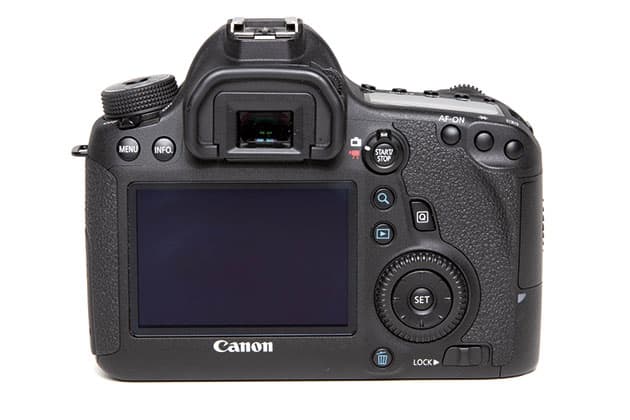
The EOS 6D accepts the widely used LP-E6 battery, which contributes to its healthy 1,090-shot life
What to pay
The EOS 6D cost £1,399 when new in 2012. Today you can pick up a used model in ‘excellent’ condition with a shutter count of under 10,000 frames for £639. Examples with a higher shutter count of around 25,000 frames deemed to be in ‘good’ condition cost around £569. The cheapest EOS 6D on MPB.com was one in ‘Good’ condition for £519; however as is to be expected of a used camera, it had a few light marks and scuffs to the body.
How it fares today
Although the EOS 6D has been superseded, the original remains widely used. It’s a very capable DSLR for a range of subjects, but its weakness is its burst rate, which at 4.5fps isn’t ideal for photographing high-speed action or sport. A resolution of 20.2MP is also more than adequate for enthusiasts who don’t require the colossal files outputted by today’s super high-resolution cameras.
New alternatives
The EOS 6D Mark II arrived in 2017. Its 26.2MP CMOS sensor offers a broader ISO range; it has a faster DIGIC 7 image processor that permits a burst of up to 6.5fps, plus it benefits from Canon’s Dual Pixel CMOS AF technology, ruling out the clumsy focusing performance when shooting stills and video in live view. There’s plenty more including a 45-point AF system and 3in vari-angle touchscreen.
What the owners think
Three Canon EOS 6D users give their verdict
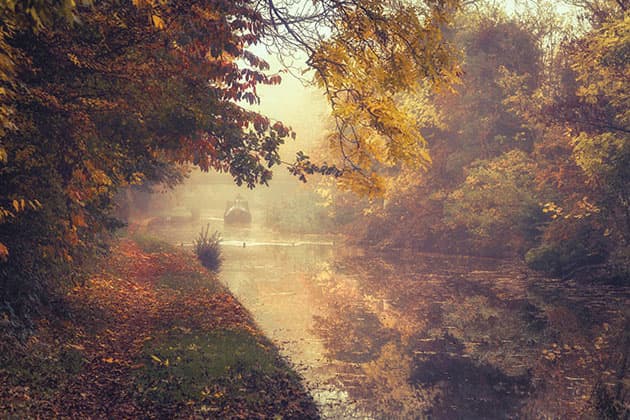
A stroll along the Grand Union Canal in Solihull on a misty autumn morning. Canon EOS 6D, Canon EF 24-105mm f/4L IS USM, 1/125sec at f/8, ISO 640. Credit: Chris Fletcher
Chris Fletcher
‘After starting out with a Canon EOS 1000D and then graduating to the EOS 60D, it was a logical step to upgrade to the Canon EOS 6D. From the moment I started using the 6D I felt that my photography took a major step forward, with significant improvement in colour definition, detail and depth-of-field capabilities. But what really stood out for me was the low-light performance. This was beyond anything I had used before, and suddenly I was able to shoot during my early morning canal and countryside strolls without a tripod, even with low ISO. I travelled extensively with my 6D. It served me perfectly while shooting mountains, lakes and architecture, even giving me the confidence to attempt night photography. It’s not the fastest camera around and has limited focal points, but it allowed me the freedom to shoot handheld at a much-improved level. This freedom suits my style perfectly, as well as gives me more scope for editing. I recently upgraded to an EOS 5D Mark IV but kept the 6D as my trusty backup body.’
For and against
+ Logical step up from an APS-C DSLR
+ Great backup camera for the EOS 5D Mark IV
– Not the fastest at continuous shooting
– Limited number of autofocus points
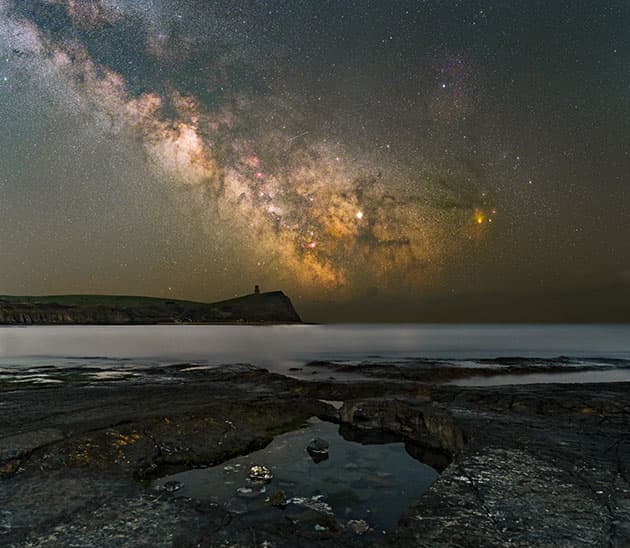
Mark modified his EOS 6D for his love of astrophotography. Canon EOS 6D, Samyang 24mm f/1.4 ED AS IF UMC, 120sec at f/4, ISO 1600. Credit: Mark Green
Mark Green
‘My first camera was the Canon EOS 500D, but as my passion for photography escalated, especially with astro/nightscapes, I needed to upgrade to a full-frame camera. The EOS 6D seemed to be the camera of choice for many astrophotographers, mainly because of its portability and low-light capabilities. I have now owned the 6D for three years, and I am still amazed at how well the camera performs at high ISO. I recently had my 6D astromodified (IR cut filter removal). This enables the camera to become more sensitive to red light, making it much easier to pick up the faint hydrogen alpha (H) gases in many areas of the night sky. This has taken what is a fantastic camera and turned it into a light-gathering machine. If you are in the market for a well-priced camera for astrophotography, look no further.’
For and against
+ Fantastic in low light
+ Performs well for astrophotography
– No in-camera battery charging
– Basic arrangement of AF points
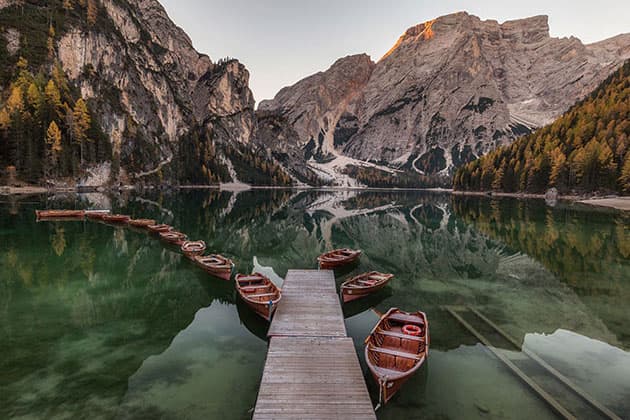
A classic view of lake Lago di Braies in the Dolomites, Italy. Canon EOS 6D, EF 16-35mm f/4L IS USM, 1/5sec at f/11, ISO 200. Credit: Tony Finnegan
Tony Finnegan
‘I’ve been shooting with the EOS 6D for a little over a year now, and I’m thoroughly impressed with this mid-range DSLR from Canon. As an amateur photographer, I can’t really fault this camera as it has everything I need and more. I stepped up from the EOS 760D and it’s been a revelation. It was a considerable jump from my previous crop-sensor body: the images were so much sharper; it retains more detail and of course the files can be pushed that bit further in post-processing. There are things I miss like an articulated flip screen, but it’s something that you can live without. As someone who doesn’t make a living from photography, I find it hard to justify spending huge amounts of money on the high-end gear when cameras like the 6D are easy enough to source second-hand at very reasonable prices.’
For and against
+ True workhorse of a camera
+ Very portable and weighs just 755g
– Weather-sealing could be better
– Lacks an articulated flip screen


